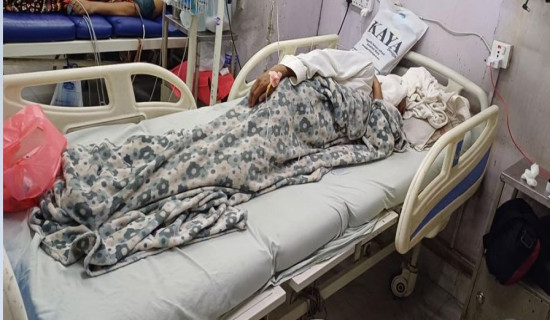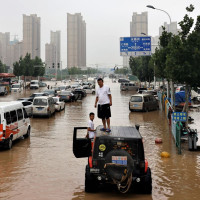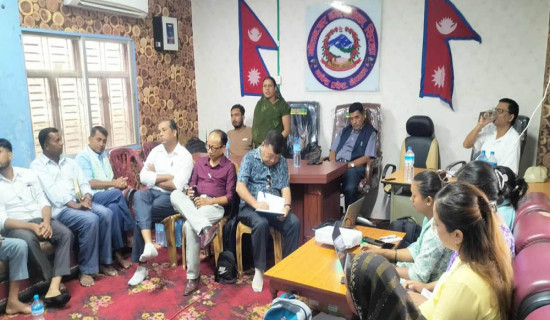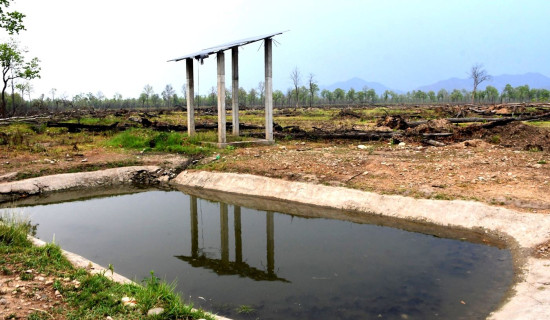- Thursday, 31 July 2025
Documenting Dhorpatan
This volume introduced here is the seminal contribution to document the multifaceted aspects about Dhorpatan brought out under the initiative of Dhorpatan Sarokar Samaj. Dhorpatan, lying in Baglung district of Gandaki province, is one of Nepal’s cultural cauldrons, known widely for its world-famous hunting reserve. Nestled amidst the rugged peaks of the Dhaulagiri Himalayan range lies the majestic Dhorpatan, which offers a glimpse into the natural and cultural wonders of Nepal. Dhorpatan Sarokar Samaj and its members and those who extended support for this publication should be congratulated for bringing out such an important volume on Dhorpatan featuring different aspects and dimensions. The volume is very rich, tinged with scholarly fervour because of the fact that the articles are written with a recourse to an interdisciplinary approach, taking intersubjective perspectives and points of view into account. The articles draw on historical, anthropological, sociological and developmental discourses to lend credence, rationale and discursive richness to them.
Basically, the articles provide a sociological and historical understanding and perspectives and insights. The sociological perspective is a way of understanding society that emphasises the interconnectedness of social structures, institutions, and cultural norms. By analysing social phenomena through a sociological lens, one can gain new insights into issues such as power dynamics, inequality, and cultural values.
As mentioned above, this volume dedicated to Dhorpatan is indeed a compendium of several articles painstakingly prepared, edited and finalised by those who hail from Dhorpatan and are currently staying in Kathmandu holding different occupations. As outlined in the publisher’s note, “This volume is actuated by the deep urge of responsibility of the persons born and grown up in Dhorpatan towards their birthplace. The book is, indeed, the creative enterprise of the persons who owe their roots to the genus of Dhorpatan and are emotionally attached to the place." The book was launched recently at a gathering of academics, scholars, researchers and local stakeholders in which there was an outpouring of praise for this commendable work by those who have an intimate relationship with the place.
Noted anthropologist Mukta Singh Lama, researcher and writer Yadav Devkota, and sociologist and teacher Shushila Sherchan had reviewed and provided their comments on the book. The experts were all praise for the efforts put in to produce the book, and they appreciated it, saying, “It epitomises the indigenous efforts at writing the local history.”
However, one of the learnt commentators singled out the fact that no Dalits, who constitute the majority in terms of demographic size in Dhorpatan municipality, were included as authors in the volume. Inclusion of Dalits in the community of authors and contributors would have been just and appropriate to incorporate Dalit perspectives in the book.
The book is divided into six segments. The first segment offers a historical account, politics and geography of Dhorpatan in different phases of time. Ujir Magar, Harichan Chhantyal, Mohan Lal Sharma and Dharma Bahadur Kunwar have contributed articles for this segment. The second segment of the book deals with social composition, ethno-cultural diversity, the history of different ethnic groups and their languages in Dhorpatan, offering a rich repository of knowledge on the subject. The articles providing a detailed account of Magars, Khas Arya, Thakali, et al., testify to the fact that Dhorpatan offers a rich tapestry of ethnic and cultural diversities.
Jhakendra Ghartimagar’s contribution on Magar is a research-based article unravelling interesting sociological facts and information, while the article by Chetnarayan Poudel on Khas Arya is also very informative. Harichan Chhantyal’s contribution on Chhantyal and their traditional mining and tunnel boring sheds rich perspectives on the subject. Similarly, the write-up on Thakali by Chhan Bahadur Bhattachan shows the commercial acumen of the group whose fame is established by their skills in trading and the hotel and hospitality sector. Likewise, Tulsi Ram Sapkota writes about the state of school education with reference to Bhuji Secondary School, which is recorded as the first educational institution in the area.
The third segment of the volume comprises the economic development aspect of Dhorpatan. The segment takes a look into the livelihood constraints and vulnerabilities in the area. The write-up by Govinda Chhantyal discusses at length different aspects of livelihood, while the article by Dr Kashi Ram Kunwar sheds light on the ways and means for the development of tourism in Dhorpatan with reference to the hunting reserve. The fourth segment includes the expert perspectives on Dhorpatan represented by the late Dr Harka Gurung and Swiss geologist and friend of Nepal Toni Hagen.
Toni Hagen made a detailed geological map of Nepal, plotted sites for hydropower projects like Kulekhani and the Karnali Bend, proposed ropeways for mountain transport, and advocated rural eco-tourism. What would Hagen think of the mindless bulldozer roads that now scar the mountains through which he walked if he was living today? Moreover, conservation expert Dr Kamal Thapa and advocate Indira Shreesh focus on the Dhorpatan hunting reserve and the issues related to sustainable development.
The fifth segment of the volume documents the experiences and perspective of the senior people who have made immense contributions for social conscientisation and development of Dhorpatan. Experiences and perspectives of senior persons like Sheshkant Kharel, Krishna Prasad Sherchan, and Rajesh Shrestha on different areas like health services and medicine, sports, and physical culture, while contributions of Santa Lal Shrestha and Shobhakar Khanal have been well documented in their respective articles. Needless to say, Shrestha made an immense contribution to the expansion and development of Burtibang Bazar, while Shobhar Khanal has been instrumental in fetching remittance income for Dhorpatan.
The sixth segment of the book is dedicated to contributions of the persons who had made significant contributions for the socio-economic and political development of Dhorpatan. The persons included in the respective articles have already passed away. Dhorpatan Sarokar Samaj should be thanked for documenting and highlighting the contributions posthumously of those who are not living now but have left their footprint for its development.
This volume will be very useful for students, researchers and spatial development planners. Moreover, this can be recommended as reference material for social science students in higher education. Similarly, materials and contents in the book can be used for local school curriculum development so that the school students can know and learn about their own history, culture and indigenous resources. Others concerned should learn from the indigenous initiative taken by Dhorpatan Sarokar Samaj and take steps to write local history.
(Rijal, PhD, contributes regularly to TRN.)
















